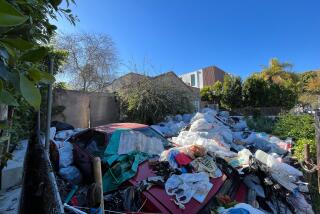L.A. sanitation agency says it cleared illegal dumping backlog

Los Angeles sanitation workers Erik Scott, left, and Cesar Galvez clean up an alley behind the 700 block of East 107th Street.
Over the past three months, the Los Angeles Bureau of Sanitation cleared a backlog of tens of thousands of outstanding requests to clean up illegal dumping, according to an agency spokeswoman.
In August, Mayor Eric Garcetti ordered the agency to address more than 41,000 unanswered cleanup requests, some dating to 2010, after an internal investigation by his office into the sanitation bureau.
The inquiry was prompted by a Times report that found the cleanup of illegal dumping in many poor areas of L.A. lagged behind such work in more affluent neighborhoods. Those disparities persisted even as Garcetti devoted new attention and money to clearing refuse from sidewalks and alleyways.
The Times found that from 2010 to mid-2015, more than one-third of logged requests to remove refuse from neighborhoods in central, northeast and South L.A. were left open — meaning no cleanup was ever recorded. Sanitation workers closed 99% of the complaints in other parts of the city.
As part of the agency’s recent efforts, crews found illegally dumped trash at about 22% of the outstanding request locations and cleaned them up this fall, according to public works spokeswoman Elena Stern. In 114 cases, the requests were referred to the city’s Clean Streets Initiative team for removal of large items or homeless encampments. The rest of the requests were found to be already clean, some of which the city said was the result of previous work done by the agency.
Sanitation officials suggested some service requests were handled properly and just not recorded in the system. They said their records were flawed because of a botched rollout last year of a new computer program intended to track service requests.
Garcetti had also instructed sanitation officials to provide an explanation for disparities in service between neighborhoods.
At an Energy and Environment Committee council hearing in September, sanitation director Enrique Zaldivar said that a “propensity of requests” in areas with poor service had amounts of trash that were beyond the capacity of sanitation crews.
“These were the very large types of requests that we would not have been able to respond to,” Zaldivar said.
Garcetti’s office directed the agency to publish data on the city’s website on response times and the amount of waste removed from sidewalks and alleys. Garcetti also wants sanitation officials to work with the city’s Information Technology Agency to improve its service tracking system.
Overall response rates have improved since Garcetti took office in 2013. But Angelenos continue to see significant differences in service depending on where they live.
For example, residents in Boyle Heights on the Eastside were still waiting for responses to 30% of the cleanup requests made since Garcetti took office. Over the same period, only 1% of complaints remained open in Van Nuys, in the San Fernando Valley, which had an equivalent number of service requests.
More to Read
Start your day right
Sign up for Essential California for news, features and recommendations from the L.A. Times and beyond in your inbox six days a week.
You may occasionally receive promotional content from the Los Angeles Times.






